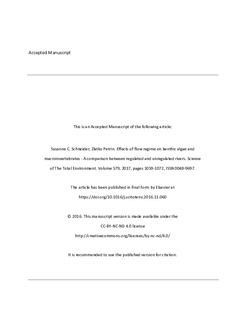| dc.description.abstract | Natural fluctuations in flow are important for maintaining the ecological integrity of riverine ecosystems. However, the flow regime of many rivers has been modified. We assessed the impact of water chemistry, habitat and streamflow characteristics on macroinvertebrates and benthic algae, comparing 20 regulatedwith 20 unregulated sites. Flow regime, calculated fromdaily averaged discharge over the five years preceding sampling, was generally more stable at regulated sites,with higher relative discharges inwinter, lower relative discharges in spring and smaller differences between upper and lower percentiles. However, no consistent differences in benthic algal or macroinvertebrate structural and functional traits occurred between regulated and unregulated sites. When regulated and unregulated sites were pooled, overall flow regime, calculated as principal components of discharge characteristics over the five years preceding sampling, affected macroinvertebrate species assemblages, but not indices used for ecosystem status assessment or functional feeding groups. This indicates that, while species identity shifted with changing flow regime, the exchanged taxa had similar feeding habits. In contrast to macroinvertebrates, overall flowregime did not affect benthic algae. Our results indicate that overall flowregime affected the species pool of macroinvertebrates from which recolonization after extreme events may occur, but not of benthic algae. When individual components of flow regime were analyzed separately, high June (i.e. three months before sampling) flow maximawere associated with lowbenthic algal taxon richness, presumably due to scouring. Macroinvertebrate taxon richness decreased with lower relative minimum discharges, presumably due to temporary drying of parts of the riverbed. However, recolonization after such extreme events presumably is fast. Generally, macroinvertebrate and benthic algal assemblages were more closely related to water physico-chemical than to hydrological variables. Our results suggest that macroinvertebrate and benthic algal indices commonly used for ecological status assessment are applicable also in regulated rivers. © 2016 Elsevier B.V. All rights reserved. stream, benthic algae, periphyton, macro invertebrates, discharge, heavily modified water bodies | nb_NO |

